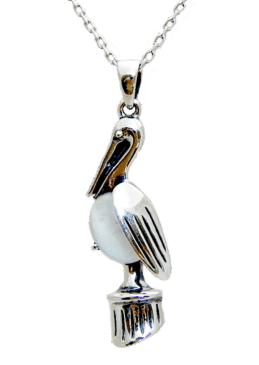St. Tammany News
Wednesday, January 25, 2012
Local artisan designs bicentennial jewelry
GIA Certified Gemologist Anne Dale
Local artisan, gemologist and jeweler Anne Dale discovered a new gemstone that will be used as part of the official jewelry commemorating Louisiana’s bicentennial this year. A brown pelican with a LaPearlite belly was selected to represent the state for the bicentennial, and members of the bicentennial committee will each have a lapel pin.
The LaPearlite, found in the oyster shell, was named Louisiana’s official gemstone in an act of the Louisiana Legislature last year. Dale discovered the tone while shucking oysters after the BP oil spill.
It was examined by several gemologists across the country, including the Smithsonian Institute. Dale was able to name the find and the named reflects the state, La, and its pearlescent qualities.
She sells jewelry crafted with the stone in her Mandeville store and online through Anne Dale.com and LaPearlite.com, but like any gemstone, Dale said it is not solely hers, but in the Gulf for anyone to find and craft.
Deeper than mother of pearl and far more precious, the gemstone is found only in the crassostrea virginica mollusk, the most important oyster to the United States. Louisiana is the largest provider in the country.
About 50 percent of these oysters are found off the Louisiana coast in the Gulf of Mexico. They live primarily in brackish water, between salt and freshwater, and are native to the area. Although they are bountiful, Anne Dale said only about 10 percent of them yield a high enough quality gemstone to be used in jewelry.
For example, if 400 oysters are retrieved, only about 40 will allow a gemstone to be carved. A rare sweet spot allows for certain minerals to be compounded in the growth of the shell because brackish water allows for other minerals to be present in the growth of the oyster shell.
This differs from the mother of pearl.
There are only a handful of natural gemstone in the United States, including turquoise and the Montana sapphire.
When it’s taken out of the shell, LaPearlite looks like a rock. However, when the polishing phase begins, the stone takes shape. The delicate procedure captures the colors and variety of inclusions in the stone that makes each one different, each one unique.
As with any art design, sometimes the polishing process does not go as planned and a natural defect will cause the stone to break apart or be discarded.
Even a pair of earrings or cuff links will not match perfectly, because nature is the artist here. Although Anne and Mike Dale will try to uncover a lot of the same colors, nature will take over to paint its own palette. What she did not say is that each one will be a true work of art, different and unique and a true one of a kind Louisiana oyster creation simply polished by man.
The discovery of the stone is another story.
Like many people in south Louisiana, when the BP oil disaster struck, Anne and Mike Dale decided to load up on oysters and seafood, not knowing what damage the oil spill would ultimately have on our cultural favorites.
After all, in south Louisiana it’s common knowledge that we live to eat. And what else is there to eat, except seafood, especially oysters and shellfish?
Distraught at the thought there would be no more seafood, they bought sacks of seafood including oysters, shrimp and crabs.
While shucking the oysters, Anne noticed a particular glint in the shell when the sun hit it in a certain way. Not mother of pearl, but something different. After digging a little, she discovered what would later be named LaPearlite.
Gemologist Anne Dale will also be an ambassador for the state the week before the Washington Mardi Gras Ball as she joins Mike Voisin, president of the Louisiana Oyster Task Force to march the hill and talk to the nation’s legislators about the beauty and economic impact of Louisiana’s tasty and beautiful delicacy, the oyster.
SOURCE:
By Debbie Glover
St. Tammany News
Wednesday, January 25, 2012

